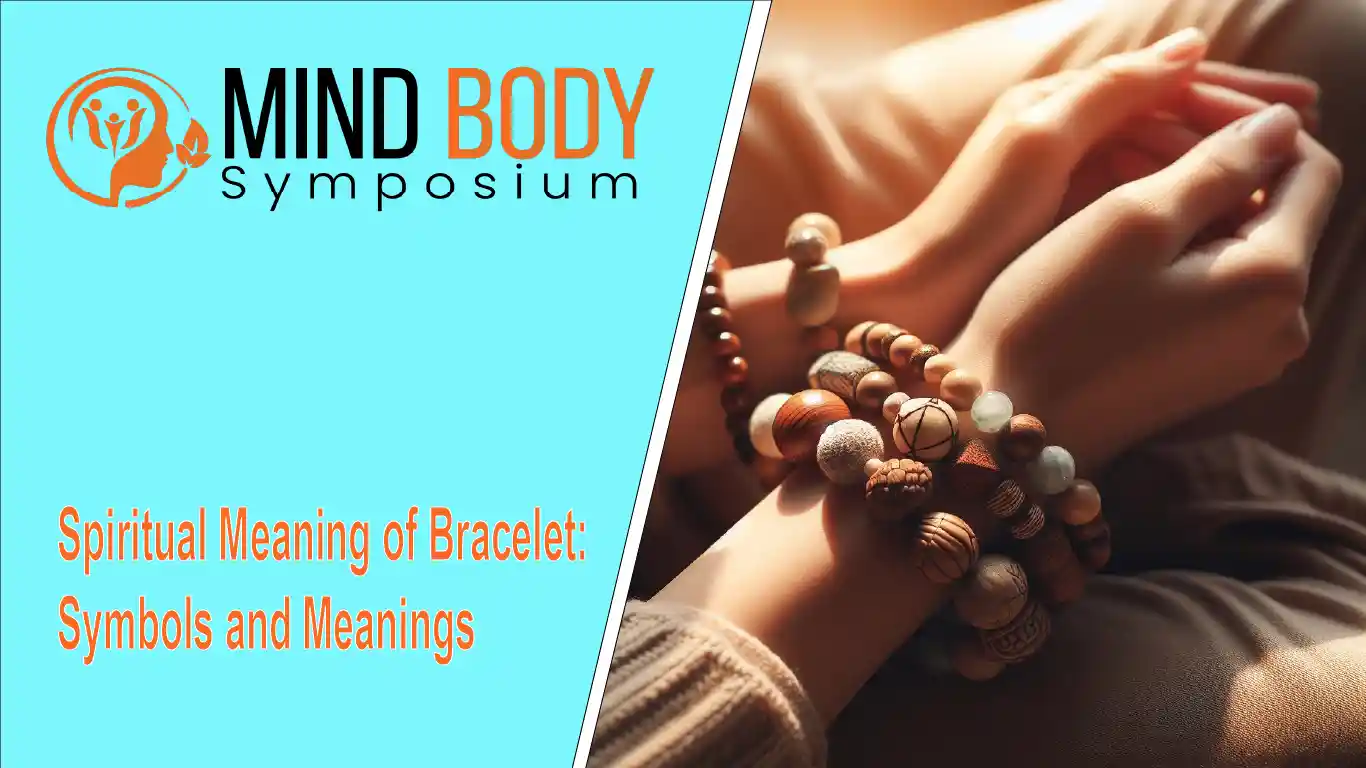In the grand tapestry of human culture, a bracelet is more than a mere ornament. It is a symbol, a talisman, a silent storyteller. Each bracelet carries a narrative, a meaning that transcends its physical form and resonates with the spiritual essence of its wearer.
Bracelets are not just fashion statements; they’re reminders of eternal love and friendship. Whether it’s a friendship bracelet exchanged between companions or a love bracelet gifted to a lover, each bracelet carries a story, a promise, and a pledge of loyalty, love, and mutual respect.
7 Spiritual Meanings of Bracelet
Bracelets have been a part of human adornment for centuries, but beyond their decorative value, they hold profound spiritual significance across various cultures and beliefs. The meanings of these bracelets often derive from ancient beliefs, cultural traditions, or spiritual practices.
#1. Wholeness
The circular shape of bracelets holds a profound symbolic meaning across numerous cultures. It is often seen as a powerful representation of interconnectedness, wholeness, and eternity. The circular form signifies the endless flow of energy and the seamless inclusivity of the universe. It encourages wearers to embrace the cyclical and interconnected nature of life, promoting a sense of balance, harmony, and unity with the world around them.
#2. Material Energies
Different materials used in bracelets, such as gemstones, metals, or threads, are believed to carry specific energies. For instance, gemstones like quartz or amethyst are thought to have healing properties, while metals like copper are said to improve circulation.
#3. Protection
In numerous societies around the world, bracelets hold special significance as they are often believed to possess protective qualities. They serve as safeguards to protect those wearing them and ward off evil energies by fighting against misfortune. One example is the red string bracelet, which is thought to protect from negative energies in different cultural traditions.
#4. Healing and Balance
Healing bracelets often contain specific stones that align with the body’s chakras, promoting balance and wellness. They are crafted to bring emotional relief and physical healing to the wearer, thus facilitating emotional and physical well-being. Similarly, charm bracelets might feature symbols with deep spiritual significance, each inspiring a particular effect, such as attracting love, prosperity, or success.
#5. Manifestation
Bracelets adorned with symbols or charms reflect personal intentions, dreams, or desires. Wearers believe these bracelets aid in bringing their aspirations to reality. Gifting such bracelets to your loved ones is the manifestation of your affection for them, and it represents an intention to strengthen your bond with them.
#6. Connection to Faith
In a spiritual context, wearing bracelets can be a tangible expression of one’s devotion and connection to a higher power. It serves as a visual reminder of faith and spiritual journey. They can be a physical representation of prayer, a reminder of commitment, or an expression of gratitude. By wearing bracelets, individuals can outwardly express their spirituality and draw strength from their connection with a higher power.
#7. Personalization
Each bracelet choice is a mirror of the individual’s inner world and symbolizes their hopes, dreams, and aspirations. This sacred piece of jewelry can encapsulate the wearer’s spiritual journey and hold great personal meaning. It serves as a tangible connection to the wearer’s core beliefs, intentions, and spiritual evolution.
Meanings Based on the Type of Bracelets
The type of bracelet, the materials used, and the symbols they bear all contribute to the spiritual significance of bracelets.
- Protection Bracelets: These are made from materials like black tourmaline or symbols like the evil eye. They are believed to shield wearers from negative energies or intentions. They incorporate elements known to ward off potentially harmful spiritual entities.
- Healing Bracelets: Crafted from materials like gemstone beads, these bracelets are thought to provide healing energies, balance chakras, or offer emotional relief.
- Charm Bracelets: These bracelets often inspire specific effects, such as attracting wealth, love, or success.
- Manifestation Bracelets: Adorned with symbols or charms reflecting personal intentions, dreams, or desires, these bracelets aid in bringing the wearer’s goals to fruition.
- Mala Beads: are Used in Hinduism and Buddhism for meditation and prayer. Typically made with 108 beads, mala beads help in focusing the mind and keeping count of mantras during meditation.
- Rosary Bracelets: are Used in Christianity for prayer, often to count prayers or meditate on the life of Christ and the Virgin Mary.
- Kabbalah Red String Bracelet: In Kabbalah, a form of Jewish mysticism, the red string bracelet is believed to protect against the evil eye and negative energies.
- Chakra Bracelets: are Designed to balance and align the seven chakras, or energy centers, in the body. Each bead or stone corresponds to a different chakra.
- Friendship Bracelets: Symbolize friendship, love, and connection. Often exchanged between friends as a token of lasting bonds and mutual support.
- Bangles: In many cultures, especially in South Asia, bangles signify marital status, prosperity, and good fortune. They are also used in rituals and ceremonies.
- Cuff Bracelets: are Often worn as symbols of strength, power, and protection. Cuffs can also represent freedom and individuality.
- Anklets: Anklets symbolize femininity, marital status, and connection to the Earth. They can also be worn for protection and good luck.
- Magnetic Bracelets: Believed to enhance health and well-being by improving circulation and energy flow, and providing relief from pain.
Meaning of the Bracelet Based on the Color
The color of a bracelet holds a special meaning and conveys a specific energy to the wearer. In various cultures and spiritual practices, colored bracelets are believed to represent different aspects of life and spirituality.
Red Bracelet:
Red is associated with passion, energy, and vitality. It is linked to the root chakra, which represents grounding, stability, and security.
A red bracelet might be worn to invoke strength, courage, and protection.
Blue Bracelet:
Blue, on the other hand, signifies tranquility, wisdom, and healing. It resonates with the throat chakra, encouraging clear communication and self-expression.
Wearing a blue bracelet could be seen as a way to enhance calmness and promote emotional healing.
Green Bracelet:
Green bracelets are commonly related to healing and renewal. This color reflects the heart chakra, which is the center of love, compassion, and growth.
A green bracelet might be chosen by someone seeking personal growth or looking to foster healing in relationships.
Black Bracelet:
Black bracelets represent protection and grounding. They are often associated with the Earth and can be a symbol of strength and resilience. Black is also considered a protective color that can absorb negative energy and offer stability to the wearer.
Yellow Bracelet:
Yellow bracelets symbolize joy, intellect, clarity, and energy. It represents the solar plexus chakra, which is linked to personal power and confidence.
Purple Bracelet:
Purple is related to spirituality, wisdom, and transformation. It is linked with the crown chakra, facilitating spiritual awareness and enlightenment.
White Bracelet:
White represents purity, peace, and spiritual enlightenment. Additionally, White is linked to the crown chakra and represents clarity and higher consciousness.
Pink Bracelet:
Pink-colored bracelet indicates love, compassion, and emotional healing. It is associated with the heart chakra and enhances feelings of love and kindness.
Silver Bracelet:
Silver is linked to the moon and enhances reflection, introspection, and psychic abilities. It represents intuition, emotional balance, and lunar energy.
Gold Bracelet:
Gold is associated with wealth, abundance, and spiritual enlightenment. It is associated with prosperity, success, and divine energy.
The Spiritual Meaning of Bracelet Breaking
In various spiritual traditions, the breaking of a bracelet symbolizes the completion of a cycle, suggesting that the bracelet has fulfilled its purpose. For example, an evil eye bracelet is believed to offer protection from negative spirits and bad luck; if such a bracelet breaks, it might indicate that it has shielded the wearer from a significant amount of negativity, and its protective capacity has been exhausted.
Similarly, bracelets made of materials like carnelian are thought to represent the vitality of the spirit; if they break, it could signify a need for emotional healing or a renewal of enthusiasm for life.
Spiritual Meaning of Bracelet Falling off
The event of a bracelet falling off can be interpreted in various ways. It is mostly seen as a signal for change, indicating that it’s time to let go of old patterns or relationships that no longer serve one’s highest good.
Some consider it as a message from the universe, prompting introspection and self-discovery, encouraging one to shed outdated beliefs and embrace new possibilities. Others interpret the event as a warning or a sign to pay attention to certain aspects of life. It could be a nudge to reflect on relationships, work, or personal well-being.
Biblical Meaning of Bracelet
In the tapestry of Biblical narratives, bracelets hold a significant place. The earliest mention of bracelets in the Bible appears in the book of Genesis.
When Abraham’s servant finds Rebekah and presents her with gold bracelets, it signifies more than a mere gift. These bracelets, weighing ten shekels of gold, were a symbol of wealth, prosperity, and divine providence, marking Rebekah as the chosen bride for Isaac and reflecting the blessing of God on this union.
Bracelets also symbolize devotion and covenant in the Bible. For instance, the exchange of bracelets between Judah and Tamar represents a pledge, a tangible sign of a promise made.
Cultural Symbolism of Bracelet
Bracelets have been a part of human adornment for centuries, carrying significant cultural, religious, and traditional symbolism across the globe, and are imbued with history, meaning, and purpose.
- China: In ancient China, bracelets made of gold and jade were believed to bring good luck and were integral to traditional wedding ceremonies.
- India: Indian culture places immense importance on jewelry, with bracelets, especially bangles, being a crucial part of a bride’s wedding attire, symbolizing marital bliss and prosperity.
- Native American Cultures: Turquoise bracelets are significant, symbolizing a connection to the natural world, and are believed to bring good health and fortune.
- Māori Culture: Jade bracelets are treasured, passed down through generations, and are seen as increasing in prestige over time.
- Christianity: The blessing bracelet is a symbol of faith, hope, and gratitude, often featuring a special charm bearing a religious symbol.
- Sikhism: The Kara, a steel or iron bangle, is one of the five articles of faith that must be worn by initiated Sikhs, symbolizing unbreakable devotion to their Guru.
- Buddhism and Hinduism: Mala bracelets are used for meditation and prayer; each bead is counted during the recitation of mantras or prayers.
FAQs
Conclusion
As we reflect on ancient symbols, we gain insight into the rich spiritual heritage and the profound meanings embedded in simple objects like bracelets. They remind us that in every era, human beings have sought to express their deepest convictions and connections through the language of material culture.
The beauty of bracelets lies in their versatility and the personal connection one can establish with them. Whether for protection, healing, connection, or manifestation, these bracelets are more than just ornaments; they are spiritual tools that accompany individuals on their quest for balance, purpose, and connection to the greater whole.

Integrative Researcher in the field of Psychology, Spirituality and Religion, Professor of Integral Psychology and Spiritual Counseling, Bilingual Psychotherapist.

